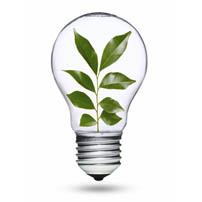Climate Change - There are solutions
 Business-As-Usual Emissions of CO2 are pushing the world
Business-As-Usual Emissions of CO2 are pushing the worldpast a climate tipping point. Fast actions needed for near-term
mitigation.
Washington, DC, July 6, 2010 - Emissions
spewing into the atmosphere now could easily lead to atmospheric
CO2 concentrations of 1,000 parts per million by the year 2200,
effectively pushing the world beyond the tipping point for
irreversible climate impacts, according to a survey of 14 renowned
climate scientists published last week in the Proceedings of the
National Academy of Sciences.
According to Dr. Myles Allen, a climate researcher at the
University of Oxford and a participant in the tipping point survey,
“We are certainly capable of committing ourselves to an emissions
trajectory that make 1,000 ppm in 2200 almost inevitable if we make
the wrong decisions over the next 20 years.” Dr. Allen’s comments
appeared in the The Independent last week.
Fast, effective mitigation measures needed
“We are moving towards an inevitable tipping point for climate
change if we don’t get our act together now,” said Durwood Zaelke,
President of the Institute for Governance & Sustainable
Development. “This study clearly shows that we need fast, effective
mitigation measures to avoid a devastating outcome down the
road.”
The future of the international climate negotiations on CO2 are
uncertain, and there is a need to simultaneously target short-term
climate forcers such as hydrofluorocarbons (HFCs), black carbon
soot, methane, and tropospheric ozone, which will lead to near-term
climate benefits.
The biggest climate opportunity of the
year is being led by Parties to the Montreal Protocol ozone treaty
who are advocating for production and consumption of HFCs to be
phased down under that treaty.
HFCs are ‘super’ greenhouse gases - some with thousands of times
the warming potential of CO2 - currently being used in
refrigeration, air conditioning, and foam-blowing for insulation.
Many ozone- and climate-safe alternatives to HFCs are now available
and many more are expected to enter the market soon, allowing
Parties to leapfrog over harmful HFCs.
The proposals submitted earlier this year by Micronesia and the
North American countries - US, Canada, and Mexico - would produce
tremendous climate benefits - over 100 billion tonnes of
CO2-equivalent in avoided emissions. Successful agreement among the
196 Parties at the November Montreal Protocol meeting in Kampala
would not only be a victory for the ozone treaty, but would create
much-needed momentum leading into the UNFCCC talks in Cancún.
“If the Parties can reach agreement in Kampala, Mexico can bring
this success and optimism to COP16, making the cooperation between
the two treaties on HFCs a shared victory for climate,” said
Zaelke. “Virtually eliminating one of the six greenhouse gases in
the Kyoto basket would be a huge accomplishment.”
Simple, low-cost technologies can also be
high-impact
Simple, low-cost technologies can also be high-impact: filters
for diesel vehicles and cleaner-burning cookstoves can
significantly reduce black carbon, which, in addition to leading to
higher temperatures and melting snowpack, is also a contributor to
deadly respiratory infections. Improved forest management and
production of biochar to sequester carbon are other strategies that
can help draw down the CO2 concentration in the atmosphere.
“This study doesn’t paint a very pretty picture of our future
world, but we still have a chance to change it - there are
solutions out there that are fast, cost-effective, and provide big
returns in climate benefits,” added Zaelke. “We need to set these
wheels in motion now if we hope to win the climate change
battle.”
Expert judgments about transient climate response to alternative
future trajectories of radiative forcing, by Kirsten Zickfeld, M.
Granger Morgan, David J. Frame, and David W. Keith,
target=”_blank”>Proceedings of the National Academy of
Sciences
Source: www.igsd.org

